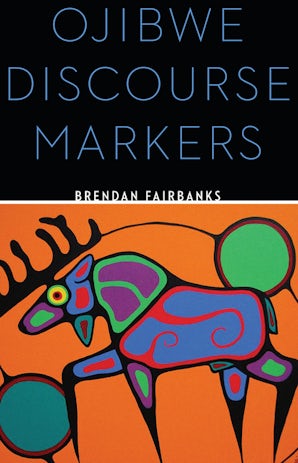
222 pages
1 glossary
May 2016
978-0-8032-9938-2
$30.00 Add to CartPreface
Acknowledgments
1. Introduction and background
1.1. The language
1.2. Why study Ojibwe discourse markers?
1.3. Methodology
1.4. Orthography
2. What is a discourse marker?
2.1. Schiffrin’s definition of discourse markers
2.2. Relevance theorists’ view of discourse markers
2.3. Cross-linguistic data
2.3.1. Position
2.3.2. Clitics and affixes
2.3.3. tam (tense-aspect-mode) systems
2.3.4. Simultaneous textual and interpersonal functions of discourse markers
2.4. Defining discourse markers
3. Ojibwe discourse markers
3.1. Discourse connectives
3.1.1. Initial position
3.1.1.1. inashke
3.1.1.2. miinawaa
3.1.1.3. onzaam
3.1.1.4. dibishkoo
3.1.1.5. mii dash
3.1.2. Second position
3.1.2.1. idash as a contrastive marker
3.1.2.1.1. Digressions
3.1.2.1.2. Backgrounding and foregrounding
3.1.2.1.3. idash in adjacency pairs
3.1.3. Preverbs
3.1.3.1. Relative preverb izhi
3.2. Mystery particles
3.2.1. Initial position
3.2.1.1. mii as a veridical marker
3.2.1.2. mii as a command softener
3.2.1.3. awenh, inenh
3.2.1.4. aaniish
3.2.2. Second-position mystery particles
3.2.2.1. isa
3.2.2.1.1. isa as a marker of closings
3.2.2.1.2. isa as a marker of relinquishment
3.2.2.1.3. isa as a marker of conclusory gists
3.2.2.1.4. isa as a marker of resultant action
3.2.2.1.5. isa as a position strengthener
3.2.2.1.6. isa as a placeholder
3.2.2.1.7. sa go
3.2.2.2. gosha
3.2.2.3. sha
3.2.2.4. da
3.2.2.5. bina
3.2.2.6. goda
3.2.2.7. naa
3.2.2.7.1. Second-position discourse clusters with naa
4. Conjunct order as a discourse-marking device
4.1. Sentence-level use of conjuncts
4.1.1. Dependent clauses
4.1.2. Temporal immediacy and the connective feature of the conjunct
4.1.3. Situational immediacy
4.2. Discourse use of conjuncts
5. Conclusion
Notes
Glossary
References
Index